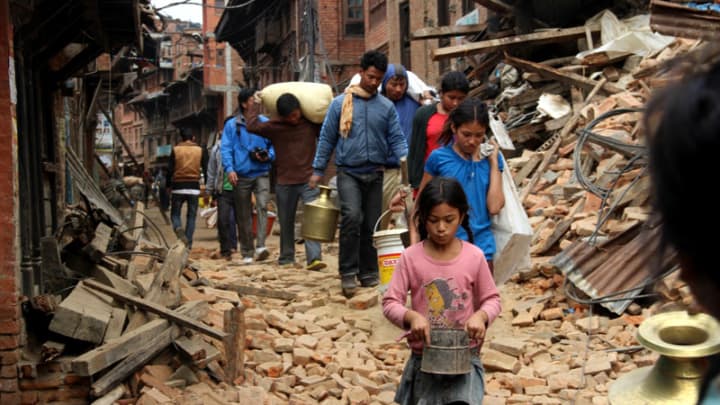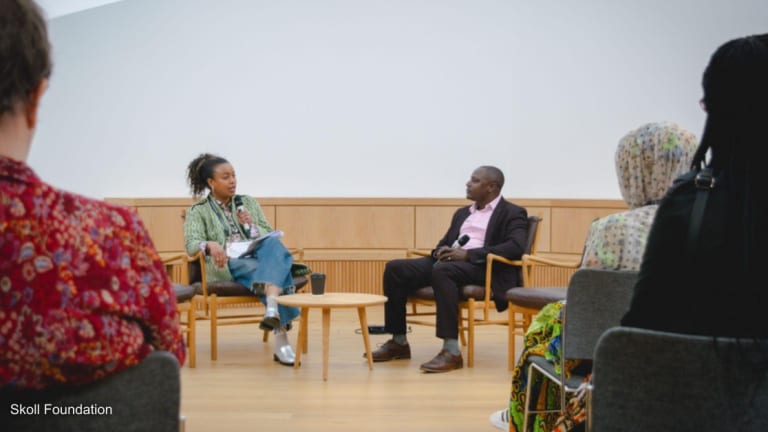
Nepal has been a focus for climate change investment for decades and for targeted, relatively large-budget, disaster risk reduction programming since the Hyogo World Conference on Disaster Reduction in 2005. Crudely put, this investment went to people predicting doom from the sky, when what has beset Nepal came from under their very feet.
Reflecting on the past three months since the earthquake I have two major observations. The first is that we question too much whether a community or household is resilient to different disasters when we should simply ask: “How strong is their natural resilience?” Nepalese are resilient and I think there are some uncomfortable realities to this.
Secondly, a great deal of spontaneous response and recovery has and is taking place in Nepal despite the formal aid effort. This is not surprising and is very often the case but the local response in Nepal may be bigger than I’ve seen before. The Nepalese I have met are definitely more resilient than those hit by other natural calamities, including earthquakes and conflict that I’ve witnessed elsewhere.
Nepal is landlocked and inaccessible, has recently experienced civil war, has no legitimately elected government and its state officials rarely leave the capital. As a result the population, particularly those affected by the earthquake, does not expect government help. Additionally, they are isolated; not just geographically but politically, economically, socially, even linguistically and have received little or no training, direct investment or capacity building in resilience.
Their existing resilience poses some fundamental questions for aid workers, like me, who are tasked with recognizing, developing and building on it in communities particularly vulnerable to natural disasters. When they are already getting on with it so well themselves, what can we add?
Today Nepalese are still clearing the rubble, salvaging materials from the wreckage and harvesting and planting as they do so.
I believe they show such high levels of resilience because of the constraints under which they live. Had they expected their government to deliver assistance, I think they’d still be sitting on their hands today. Instead, they are getting on with it without depending on others, using indigenous skills and demanding very little materially from state institutions or nongovernmental organizations.
The second dimension of this resilience is even more impressive and should be game changing.
Mass community-led participation in the earthquake response took place — beyond official or NGO responses — and continues today. It has gone almost entirely undocumented or acknowledged.
This happens everywhere — it happened in the Philippines and Haiti — but has been extremely effective in Nepal. The sheer range of people involved — from doctors and dentists spontaneously running health camps, motorcycle clubs relocating as volunteers to remote districts, local radio presenters acting as real-time response coordinators when “official” services went down, to mass cleanup campaigns — is remarkable.
This spontaneous response and mobilization was coordinated through social media, as while phone networks crashed in the initial hours after the quake, email and Internet functioned well.
Agencies could use this to see where the need is and tap into immediate information sources. But why use information gathered through social media to shape your own response? Why not support the response already happening? It will always be quicker, more targeted and more nuanced than anything externally driven. It will also be far, far quicker.
What’s heartening is that both phenomenons — community resilience and local response — resonate with Christian Aid’s approach to working in disasters, both philosophically and practically.
I attended a shelter meeting in Kathmandu three weeks after the earthquake and it was almost entirely run by foreigners. Good-intentioned foreigners, but perhaps with little local knowledge. I passed a note to Lajana Manandhar, the executive director of Lumanti, the only Nepalese NGO working on housing and shelter issues. I was lucky enough to have worked with them before and wrote: “How much cash have you got?” I thought she would have been inundated with offers from international agencies, but the answer came back: “Not one rupee!” The only local NGO delivering housing had been totally ignored. Needless to say the organization is now a Christian Aid partner.
If Lumanti can be sidelined, how do we expect agency-led aid efforts to link into spontaneous community response? There is a real need here and Christian Aid is better positioned than many due to our partnerships with local organizations.
In terms of resilience we need to stop working top-down and assess what is in front of us, looking at resilient communities and understand what makes them tick.
Secondly in terms of response we should take some risks, with our own funds, and support these immediate and spontaneous responses. It’s high risk, but high gain too. Not just in terms of speed of delivery but in terms of supporting indigenous, sustainable and appropriate resilience too.
Join the Devex community and access more in-depth analysis, breaking news and business advice — and a host of other services — on international development, humanitarian aid and global health.
Read more stories on the Nepal earthquake response:
► Red Cross and DFAT: A 'genuine' partnership focusing on humanitarian response
► Danger of an invisible generation in Nepal if registration not prioritized
► An overlooked part of the Nepal quake response: Mental health
► OCHA trims operations in DRR-capable Asia-Pacific
► Nepal vows transparency, efficiency as donors pledge billions in aid




